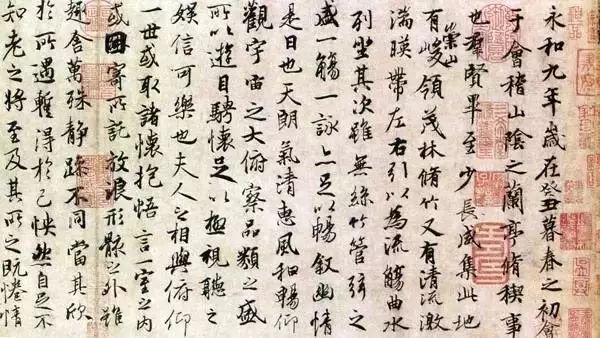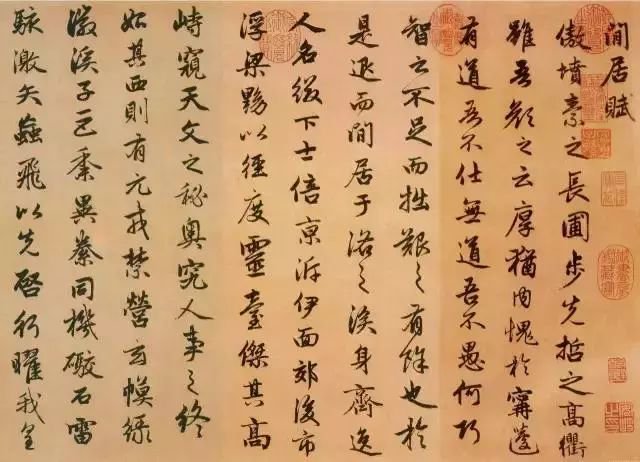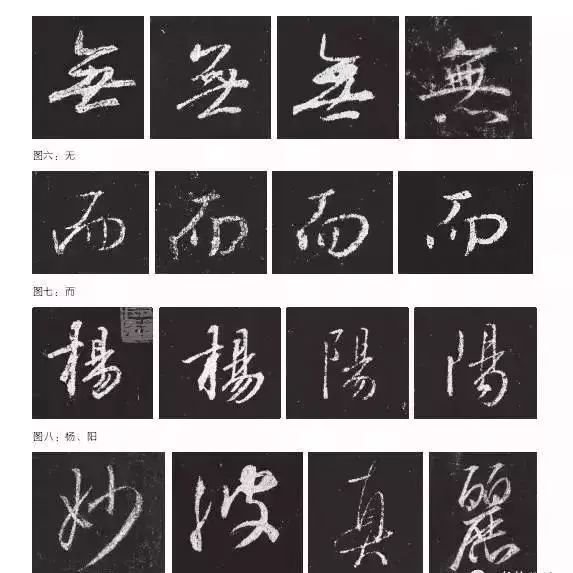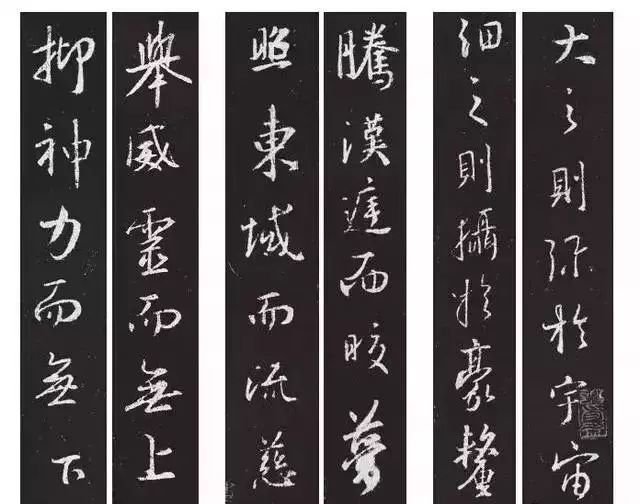1. The road to learning running script. There are various concepts and methods for learning running script.
The author has summarized a path and method for learning running script from many years of calligraphy learning experience, and I would like to share it with readers in the hope that it will be of some benefit to beginners.
First of all, it is advisable to start learning running calligraphy from people in Jin Dynasty. why? Because running script reached the highest peak in Chinese history during the Eastern Jin Dynasty, and it has not been surpassed to this day. There is a saying from the ancients: "The best way to get the best is from the middle." In other words, if you start studying the best examples, learners can only learn at an intermediate level. Therefore, if you want to learn the best, you must start from Jin people. If you "take the method to the middle", you will get "only the inferior". People from Jin Dynasty started from Wang Xizhi.
Wang Xizhi was regarded as the sage of calligraphy and a model for learning in the past dynasties. Everyone who wrote calligraphy in the past dynasties came from Wang Xizhi and started to learn from Wang Xizhi from the "Preface to the Holy Teaching".

"Lanting Preface" is the best running script in the world, why not start with "Lanting Preface"? "Lanting Preface" is not suitable for beginners. In 353 AD, Wang Xizhi and others gathered in Lanting, Shanyin. One is drinking; the other is sighing together and sighing about life. In a state of intoxication with wine and emotions, he wrote the "Preface to Orchid Pavilion" in running script. After he woke up from his intoxication, he could no longer write.

One of the greatest calligraphy geniuses could not write without leaving the situation at that time. For beginners and post-students to start from him, it is completely inconsistent with the epistemological principles and laws of step-by-step and cannot be learned well. Furthermore, the existing "Lanting Preface" is a copy of the work in the Tang Dynasty, and the copies by Ouyang Xun, Yu Shinan, and Chu Suiliang are opposites and are inaccurate.
The most famous copy by Feng Chengsu also uses double hooks first and then fills in ink. It has no free writing strokes and ink speed, so it has the least charm, so it cannot be said to be "adequate to the method". Many people have written "Lanting Preface" in the past dynasties, but few have achieved results.
There are many advantages in starting from the Preface to the Holy Religion: The full name of the Preface to the Holy Religion is "The Preface to the Holy Religion of the Tripitaka of the Tang Dynasty". It was made by Emperor Taizong Wen, and was collected by Shamen Huairen of Hongfu Temple and written by Wang Xizhi, the right general of the Jin Dynasty. That is to say, Huairen selected Wang Xizhi's running script and compiled it, so the characters are excellent and standard, and it is a classic among classics; because the characters are arranged in a collection, each one is independent, which is easy for beginners to learn; because the stone is carved, the line speed is slowed down, and the writing is more leisurely, making it easier for beginners to learn ; Because of stone carving, the sense of vastness, power and interest are increased; because of stone carving, microscopic reflections and miscellaneous details are eliminated, and the brushwork is more macroscopic, making it easier to write larger words and facilitate creation.

"The Preface to the Holy Religion" is nearly 2,000 words in total. If you understand the "Preface to the Holy Religion" thoroughly, Wang Xizhi's writing style, radicals, structure and other elements will be complete; "The Preface to the Holy Religion" is a long and beautiful article. If you understand it, you can improve your literature. level, you can also understand philosophy and Buddhist ideas, which is beneficial to improving your own Chinese studies. After that, he transferred from the "Preface to the Holy Religion" to Wang Xizhi's calligraphy manuscripts, and from the calligraphy manuscripts to Xiaocao's "Seventeen Posts". On this basis, he expanded the scope of study and moved from copying to creation. Among them, reading is throughout the whole process.
In summary, the road map for learning running script is: learn running script from Jin people → learn Jin people from Wang Xizhi → learn Wang Xizhi from "Holy Teaching Preface" → transfer to Wang Xizhi's ink handwriting → "Seventeen Posts" → expand the content →Creation.

2. Copying of running script Copying means two behaviors: copying and copying.
The original meaning of lin is to look down at something, that is, to look from top to bottom. Imitation refers to writing according to the original script; the original meaning of imitation is to comply with standards and regulations. In calligraphy, it specifically refers to covering the script with thin and transparent paper or describing the words that have been double-hook, which is also called tracing red. The word "copy" here generally refers to copying.
1. The value of copying has been proven by history and practice. There is a special rule in learning calligraphy, a unique traditional art in China, which is to copy first and then create.
Calligraphers in the past dynasties have grown up in this way, and the so-called "the pond water runs out of ink" is a portrayal. So far, no one has been found who has achieved success in creation without first copying the ancients. Therefore, copying is an irreplaceable special rule for calligraphers to learn calligraphy and write with reason.
Only by copying can one master the ancient method. Masters of calligraphy in the past have created models of different styles. Only by copying can we understand and master the secrets of their brushwork, structure and style.
Only by copying can we inherit the classics. There are two connotations of a calligraphy work. One of the connotations is how many classics it has been inherited. Without the expression of classics, there will be no ancient style and no taste. Because the humanistic ideals of ancient literati advocating virtue and tranquility are contained in it; the second connotation is the expression of personal temperament and the pursuit of personality. But it builds on the former.

Copying is to replenish energy. Copying in calligraphy is equivalent to sketching in painting, and is the main way to obtain creative resources, energy, and motivation. Because the sun and the moon wear down memory and technology, copying will accompany the calligrapher throughout his life. The shallowness and sameness of creation in today's calligraphy world is mainly due to insufficient copying and inheritance.
There is fun and enjoyment in copying. Copying ancient texts may be difficult at first, but once you get started, it will be fun. The ancients believed that Lin Tie has the "self-entertainment function", which can eliminate worries, purify the soul, enrich the spirit, move toward elegance, enjoy it, and have fun in it. The value of copying is so great that I won’t go into details due to space limitations.
2. The standard and purpose of copying. There is only one word for the standard of copying.
picture. To achieve the standard of "likeness", we must first overcome the desire for self-expression. People's desire for self-expression is innate and is expressed all the time. At the same time, people also have a beautiful ideal. They don't want to be book slaves. They always want to be able to gather the strengths of hundreds of schools of thought in ten or eight days and become unique. In fact, this is a misunderstanding. This ideal is only suitable after studying for several years. Therefore, starting from copying, we must get rid of misunderstandings. Even if it is very similar to the ancients, "resembling" Wang Xizhi still requires talent, and it is not a low honor. The second is to pay attention to methods. The third is to be more present and put in more effort. Only in this way can the standard of "likeness" be achieved, and the more likeness, the better.

The purpose of copying: to change writing habits. The fundamental purpose of copying is to change writing habits. You must change your writing habits to Wang Xizhi's writing habits. Habits are the most common and stubborn natural manifestations in life. It is not easy to change them. There must be a natural process from the unnatural to the new. It must go through a lot of copying training and develop muscle memory. Once you make a move, you will be like Wang Xizhi. , then the purpose of copying is achieved! At the same time, special attention should be paid to writing opportunities in daily life, official documents, and meetings. Although it is a hard pen, you should also bring the feeling of the copybook into your writing.
3. The method of copying is to compare copybooks and write according to the original. The more similar the writing is, the higher the score will be.
There are two stages of confrontation: first, Tonglin. Tonglin means writing from beginning to end. Generally, it is required to read the post two or three times to have an overall impression of the post; the second is to read it carefully. The most effective method is actually the stupidest method, which is to copy word by word over and over again.

method one
Analyze and compare: Analyze clearly before writing, so that you have a clear idea and a reason for writing.
First, use a pen for analysis. As mentioned before, there are only two writing methods for all the characters in the copybook, square pen and round pen. It's easy to remember the two words "square and circle". Among them, the most important thing is whether the stroke is square or round. Such as "Da, Tang"
Second, "hidden" and other words. (See Figure 1) The first horizontal stroke of the word "大" is a round stroke, and the second stroke is a square stroke. Once the analysis is clear, you can start writing. If you don't analyze, the second stroke It is easy to write a stroke with a square stroke, which is wrong; the first stipple stroke of the character "Tang" is a round stroke, the second horizontal stroke is a square stroke, the first vertical stroke below the mouth is a round stroke, and the second horizontal stroke is a square stroke. The first two strokes of the character "三" are round strokes, and the third stroke is a square stroke. Because it is the main stroke, it must be a square stroke; the first stroke of the character "Tibet" is a short vertical stroke, which is a square stroke, and the second stroke is a short horizontal stroke. It's still a square pen, the third short stroke is a round pen, the fourth stroke is a round pen, the fifth stroke is a round pen, the sixth and seventh strokes are round... the last stroke is a square stroke, and the dot is a round pen. .
Every word we write must be analyzed above. This means we have a reason to write and write confidently.
Third, analyze the structure. As mentioned before, the structure of running script changes a lot and needs to be analyzed clearly. Structure is also two words, one is shape, that is, shape; the other is momentum, that is, posture. After analyzing these two points thoroughly, I feel more aware and confident. Such as "Jiang, Fu, Gai, Yi" and other words. The character "Jiang" is open at the top and closed at the bottom, the character "Fu" is open to the left and closed at the right, the character "Gai" is closed at the top and open at the bottom, and the character "Yi" is high on the left and low on the right.
(See Figures 2 and 3) Comparison: After writing, compare with the original characters. Use the original character as the standard and see where you are not like it, including the brushwork, shape, and posture. If there is any difference, write it down again. Revise it as you write, compare and correct it over and over again, and so on. When it looks like it, consolidate it a few times and make it your own.

Method Two
Interesting Copying Method As mentioned above, copying has the function of self-entertainment, and you can enjoy happiness from it. How can we have fun and be happy? According to psychological theory, first, if you learn something similar, you will have a sense of accomplishment and happiness. As the saying goes, "There are three things that look alike", which is an expression of feeling good about oneself, that is, an expression of happiness; secondly, when you discover unusual things, you will feel novel and happy; thirdly, you will feel happy about the special things. When there is excitement in fresh life, there will be happiness.
Therefore, we try our best to be as realistic as possible, strive to find unique features, and ultimately give each word a vibrant state. Such as "Yes" (see Figure 4), "Gu" (See Figure 5), "Wu" (See Figure 6), "And (See Figure 7)", "Yang" and "Yang" (See Figure 8). Form; another example is the creativity of the word "True", the deformation of the word "Yuan", the convergence of the word "Li", the freedom and ease of the word "Miao", etc. (See Figures 9 and 10) Each character is unique and far away from the image of Chinese characters we originally established. From it, we can understand an inexplicable and wonderful feeling. We can’t stop, can’t control it, and are fascinated by it. , the more you pursue it, the more interesting it becomes, and the more you write it, the more charming it becomes. This is nothing but enjoyment!

Method three
It is illegal to do this when you have time. There are many ways to post a post, and I feel that the above two methods are the most practical and effective. What needs to be emphasized is to develop the habit of writing posts, and don't do whatever you want as soon as you pick up the pen. Because all the dragons and phoenixes that do not follow the ancient methods have zero value, and all the dragons and phoenixes that do not follow the ancient methods are superficial freedom and happiness. Only by truly working hard, copying the Dharma, and developing the writing habits of the ancients can we enter a high level of freedom and happiness. Here are five words of truth for readers: Post when you have time. A person who posts when he has time will naturally develop an elegant personal temperament and style.
Memorizing is a means of testing learning results. Only by being able to memorize can you truly master the ancient method. If you truly have new and advanced writing habits and abilities, you will have the foundation for creation.
Facing method. Don't be greedy for too much, but proceed word by word, sentence by sentence, paragraph by paragraph, and page by page. The method is more flexible. You can start from any page and choose the page you like best; you can write the Heart Sutra first, which is 266 words long, and the content is easy to memorize; you can also choose beautiful words or sentences that are easy to memorize. Choose good words and sentences to awaken the memory of calligraphy images; copy or print out the original content. It will be easier to memorize only the glyphs and not the content; proofread the memorized results against the original posts and correct deficiencies in a timely manner.
Good words such as: Buddhism and Taoism worship emptiness, take advantage of secludedness to control silence; promote blessings for thousands of things, guide and govern the ten directions; (see picture 11) still lost in wisdom, peek into the sky and learn about the earth; understand the yin and cave yang; the four seasons are invisible, etc., They abound.

Good sentences such as: Raising the mighty spirit is supreme, suppressing the divine power without being inferior; rising to the Han court brings bright dreams, shining the east region and flowing kindness; the big one fills the universe, the small one is captured in a millimeter; gold The appearance and color cannot be reflected by the light of three thousand people, the beautiful elephant has four or eight phases in the sky, it is indestructible and has no birth, and it lasts for thousands of kalpas, but it is not ancient.
If you can memorize one word, this word belongs to you. If you can memorize a hundred, a thousand, or three thousand words, these thousands of words will all be yours. Has he become Wang Xizhi? Yilin Yilin is a higher level of Linxi practice based on memorization. It is the performance of a more in-depth understanding of the original post. This is a relatively difficult stage.
Especially in terms of "what does it mean", the requirements are high. If the result of mental presence is far less than that of spiritual presence, it proves that the ability of mental presence is not yet available. In the final analysis, Yilin is a kind of creation and an important process of publishing a post. The ancients said that "it is easy to enter a post but difficult to get out", and this is the main idea.








